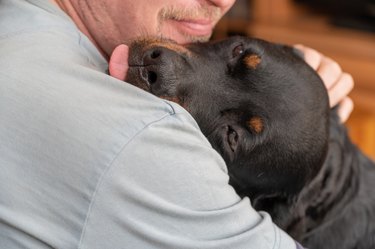You're petting your dog after they fetched and returned with the tennis ball for the hundredth time (and they're not worn out yet!) and you unexpectedly feel a hard lump. Your first reaction may be to quickly stop the game and give their whole body the once over. While it is scary to feel a hard lump on your dog, no matter where it is on their body, don't panic!

Video of the Day
A hard growth that feels like a pea-sized lump under your dog's skin may be the result of something that is perfectly normal. Get any lump checked out by a vet though, as some bumps may be tumors, and early tumor detection makes a big difference in your pet's prognosis.
Video of the Day
Cancer in dogs
Cancer is the most common cause of death in dogs, says the Journal of Veterinary Internal Medicine. The Journal reported on a study looking at 82 dog breeds, and cancer was the leading cause of death for 71 of the breeds studied. And, according to the Veterinary Cancer Society, 1 in 4 dogs will be diagnosed with cancer, making it the leading cause of death in pets who are beyond middle age.
Sometimes, the signs of cancer are not apparent at first. You may notice that your dog has a small bump somewhere, but at the same time you may feel that they are eating, drinking, and playing normally so there is nothing to worry about. As it turns out, abnormal growths, lumps, or tumors are among the most common signs of cancer in your pet, so don't ignore them if you see them. The National Cancer Institute's Center for Cancer Research says that each year about 6 million of the 65 million pet dogs in the United States will be diagnosed with cancer.
Hard lump on dog
Dogs develop hard lumps for a variety of reasons. For example, temporary hard lumps under a dog's skin might form after your dog has had their shots. These may last for a few weeks or in the case of rabies vaccine, a month or more. Make note of where your veterinarian gave the vaccines so you can monitor these areas. If a lump lasts beyond a month after a vaccine (or gets bigger at any point after vaccination,) contact your veterinarian.
Other potential causes include blocked hair follicles, bug bites, a blood clot that appears as a lump on the skin (called a hematoma), and even cysts. These can all turn into lumps that are not the same as a cancerous lump. A cancerous lump will behave differently than a non-cancerous lump in many cases.
Cancerous lumps will often grow quickly. It may change its color or appearance in other ways, and it will likely also do this quickly. A cancerous lump may have a different color of skin than the skin around it. It also may feel like you can't tell where the edges of the lump end.

Hard knot on dog's head
If you feel a bump on a dog's head between the ears, it could be what is called a "wisdom bump." It is also called a "knowledge bump" or a "knowledge knot." In times past, this was considered a sign of a dog's intelligence.
Dogs with prominent bumps on their heads are hounds, especially bloodhounds, golden retrievers, Labrador retrievers, and English setters. The hard knot on a dog's head is officially called an "occiput or sagittal crest" and it is simply an anatomical feature that makes the skull stronger to provide additional protection for the brain.
When is a lump serious?
How do you know when it is time to consider a hard growth on your dog a serious issue? Some of the signs that you should look for when determining if the hard growth on your dog is a serious problem.
The lump is fast-growing: A fast-growing lump may need to be removed, whether it is cancerous or not. If a growth does need to be removed, it is easier to remove it when it is small. Also, a large growth may impinge on nerves or some other movement or behavior that could impact your pet's quality of life.
The lump appears to be painful: If you touch your dog's lump and they are obviously in pain from it, it could be an infection.
There's discharge from the lump: Some cancerous lumps can break open and bleed or get infected. And really, anything oozing from a lump that's cloudy, green, or yellow is a sign of infection.
The lump's size changes: A lump that fluctuates in size could be a mast cell tumor. These bumps can be itchy. The change in growth is a result of the tumor containing a histamine that swells in size, and then reduces in size as the histamine is released. It is best to remove these types of tumors in dogs while they are small. However, be aware that mast cell tumors are not always hard; this type of cancer can look and feel exactly like benign fatty lipomas. These tumors can be beneath the skin or on the skin, and can look completely different from one dog to the next.
You see a cluster of smallish bumps that appear suddenly and grow in size: This could be a sign of an allergic reaction.

Types of tumors in dogs
There are 12 common types of lumps and bumps on canine skin that you may likely see.
Lipoma: Lipomas are common, benign tumors filled with fat that lodge under the skin. They are soft, round, and do not hurt your dog. They are also more common in overweight dogs, although any breed can get lipomas.
Histiocytoma: Dogs under six years of age get these and they typically go away on their own. A histiocytoma is a red, button-like lump that's thought to be caused by an overactive immune system. These can resemble other forms of cancer, so get it checked to be sure it is a histiocytoma.
Perianal adenoma: These are noticeable around your dog's anus. While common, an un-neutered dog is more likely to get these.
Skin tag: This is a common growth in which the skin develops "extra" skin where it shouldn't be. They are harmless and dogs of any breed may develop them.
Sebaceous cyst : This is a fancy name for a plugged oil gland in the skin. In humans, we might call this a large pimple. These are harmless.
Abscess: This is a sign of infection that can be anywhere in the body under the skin. It is painful and may feel soft and squishy. It can often be caused by an external injury such as an insect bite or animal bite that gets infected.
Hives: This is a collection of bumps similar to a rash. The cause could be an allergic reaction to something like a bee sting or an irritating plant.
Warts (papillomas): Warts are caused by a virus, and they can pop up anywhere, just like they do in humans. While canine papilloma virus warts are highly contagious and can be spread among dogs sharing bowls and toys, old dog warts are different and are not contagious. Warts are usually harmless.
Melanoma: There are four types of melanomas in dogs: eye, nail bed, oral, and skin. Up to 80% of canine melanoma cases are in the mouth, and the nail bed is the second most common with up to 15 to 20% of cases; both of these types of melanomas are malignant and not easy to treat. Melanomas in the mouth and at a dog's toes near the nail bed can be aggressive, spreading to other parts of the body and requiring treatment including chemotherapy, radiation, and immunotherapy. Eye and skin melanomas, on the other hand, tend to be benign.
Mast cell tumor: This is the most common skin cancer in dogs. Certain breeds including boxers, Boston terriers, Labrador retrievers, beagles, and schnauzers are more prone to them. These tumors can have a widely variable appearance that can resemble other lumps and bumps. They may be small or large, and they may or may not be hairless.
Soft tissue sarcoma: Soft tissue sarcomas usually appear as a firm or semi-firm lump deep in the connective tissue, nerves, or muscle. They are usually not painful, although those within the muscle can be, and although they're not terribly common, they're most likely to be found among middle-aged and older large-breed dogs
Squamous cell carcinoma:This is a skin cancer that is often found in the mouth, skin, or on a dog's nail beds. These are associated with sunlight exposure so they commonly appear in areas on a dog's body where there is less hair.